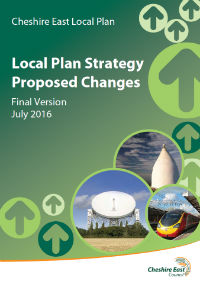Landmark day as Cheshire East Council adopts Local Plan
July 27, 2017

Cheshire East Council has today sealed the formal adoption of its landmark Local Plan.
The decision comes after a planning inspector last month gave Cheshire East’s strategic blueprint for shaping development in the borough up to 2030 a ‘clean bill of health’.
Approval by a meeting of full council today follows three years of submissions and a total of more than 60,000 comments during 11 separate rounds of public consultation. This represents ‘an unprecedented level of interest’ in a council consultation process.
Importantly, the inspector, in his final report to the council, highlights that the plan provides a five-year supply of housing land to meet projected need. This is a key finding that will now support the council’s case against inappropriate or unsustainable housing proposals.
Councillor Rachel Bailey, leader of Cheshire East Council said today: “It has been a long and sometimes difficult journey but we understood the importance of getting this blueprint right – and the adoption of our Local Plan is great news for the people of Cheshire East.
“The Local Plan is the council’s most important tool for shaping development in Cheshire East to 2030 – so today is a landmark for this authority, local businesses and our residents.”
Councillor Ainsley Arnold, Cheshire East cabinet member for housing and planning, said:

“The planning inspector acknowledged that our Local Plan was one of the most complex and consulted upon he had seen in his more than 20 years’ experience.
“There has been a tremendous response from our residents and other stakeholders during the very extensive rounds of public consultations and I’m sure it has allowed everyone to feel they had the opportunity to have their say on the plan.
“Our Local Plan has been shown to be both comprehensive and robust and will give the people of Cheshire East its best protection against unplanned and unsustainable development. It also gives shape to where future growth in housing, employment and infrastructure will be accommodated within our borough.”
Planning Inspector Mr Pratt said in his final report in June: “I consider the overall development strategy for Cheshire East, including the provision for housing and employment land, is soundly based, effective, deliverable, appropriate, locally distinctive and justified by robust, proportionate and credible evidence and is positively prepared and consistent with national policy.”
Sean Hannaby, the council’s director of planning and strategic development, said: “As a council, we are picking up the challenge from Whitehall to accelerate delivery of new homes to meet demand.

“Under our Local Plan we see a significant increase in our new-build to 1,800 homes per year. The plan also identifies more than 2,500 acres of land for housing – an area equivalent to around 2,600 football pitches
“We have already been building houses at an increasing rate to help meet demand, with completions totalling 1,760 homes in 2016/17 – a four-fold increase on the figure for 2010/11. On top of that we have 400 sites currently under construction and current planning consent for more than 20,000 homes.
“I would like to take this opportunity to pay tribute to the incredible hard work of our officers and members to successfully deliver a robust Local Plan for the people of Cheshire East.”
Cheshire East’s Local Plan includes provision for a housing requirement of at least 36,000 new homes and 380 hectares of development land, to reflect a stronger anticipated jobs growth rate of 0.7 per cent per annum.
The inspector endorsed all of the 60-plus strategic sites within the Local Plan, including larger-scale proposals, such as the North Cheshire Garden Village at Handforth.
He also supported the council’s strategy of making modest amendments to green belt land and the other key policies regarding the maintaining of ‘green gap’ land between settlements. However, less than two per cent of the borough’s green belt land will be affected by the increased development need.
For further information about the Local Plan, recent consultations and links to key documents, visit our Local Plan pages.